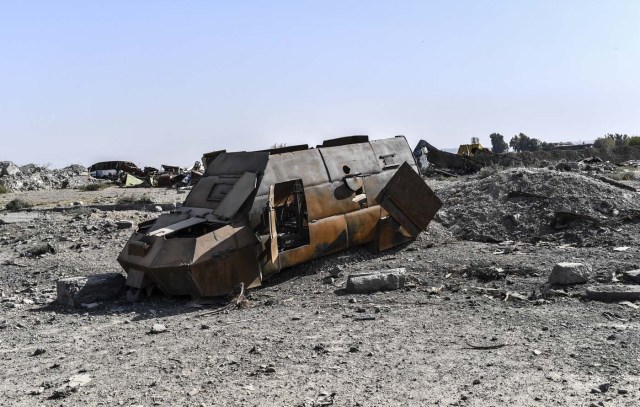
Cuando Asya vio los escaparates reventados en su calle comercial preferida se echó a llorar. Su casa fue bombardeada. Tenía la intención de vivir de nuevo en Raqa. Ya no.
“¡Dios mío! Era la ciudad más bella”, declara esta siria de 35 años, sentada en los asientos de atrás de un coche, en la avenida Tal Abyad, antes bulliciosa y ahora alfombrada de escombros.
“Ahora mire a su alrededor, mire nuestras casas”, dice llorando.
Asya forma parte de los pocos civiles que han podido acceder al centro de Raqa, desde que una alianza de combatientes kurdos y árabes apoyada por Estados Unidos expulsó al grupo Estado Islámico (EI) que la había autoproclamado su “capital”.
El viernes, las fuerzas antiyihadistas organizaron una ceremonia para oficializar la captura de la ciudad, devastada después de cinco meses de combates. Pero la cantidad de minas colocadas por el EI impide por ahora la vuelta de los habitantes.
Algunos familiares de los combatientes y las autoridades locales han conseguido el salvoconducto de un día para asistir a la ceremonia. Aprovecharon para echar un vistazo a sus casas.
Es el caso de Asya y de sus cuatro hijos, que fueron en un coche conducido por su marido, un combatiente antiyihadista. Después de la ceremonia, quisieron ver su barrio de Al Rumeila, en el este de la ciudad.
“Mi casa fue bombardeada, me di cuenta cuando vi todas nuestras pertenencias esparcidas fuera”, cuenta Asya. “Hubiera preferido que hubieran robado todo pero que los muros siguieran en pie”.
– ‘Destrucción, dolor, tristeza’ –
Se proponía regresar con su familia a su ciudad natal, de la que huyó al principio de año. Ahora “no quiero volver”, dice.
“Todos nuestros recuerdos bonitos se han transformado en tragedias”, asegura Asya, tocada con un velo de color mostaza.
A su alrededor, en la avenida, se adivina qué era cada comercio por los detalles: un panel roto delante de una clínica infantil, mostradores vacíos de lo que queda de una joyería, bobinas de telas y máquinas de coser en una sastrería.
La ciudad quedó desfigurada.
Una vez desminada, la alianza kurdo-árabe entregará el control al Consejo Civil de Raqa, una administración provisional. Sus miembros también han podido verla por unas horas y se llevan un recuerdo agridulce.
“Estamos felices de haber vuelto, pero hay destrucción, dolor, tristeza”, declara la abogada Fadila Hamad al Jalil, quien huyó de Raqa en abril.
“No me imaginaba que la destrucción fuera tan extensa. No parece real, no queda un edificio ni una infraestructura en pie, no hay ninguna señal de vida”, reconoce esta mujer, que asistió a la ceremonia como miembro del Consejo Civil.
A Jalil le habría gustado venir con su familia y sus amigos de infancia, pero el desminado llevará tiempo, a lo mejor meses.
– ‘Reducida a esto’ –
La incursión breve en la ciudad permitió a Mahmud Mohamed, miembro del comité encargado de la reconstrucción en el seno del Consejo Civil de Raqa, medir el alcance de la tarea que le espera.
Desde hace semanas, un grupo de ingenieros como él elaboran planes para el restablecimiento de la red de agua y de electricidad.
El joven, de 27 años, se da cuenta de que era demasiado optimista.
“Veíamos las imágenes de Raqa (durante los combates) pero no sabíamos y no anticipábamos que hubiera quedado reducida a esto”, dice mientras hace fotos de los daños en la avenida Tal Abyad, donde su familia tenía varios comercios que permanecieron abiertos incluso en tiempos del EI.
“La envergadura de la destrucción es mucho mayor de lo que nos imaginábamos. El plan (de reconstrucción) ha cambiado completamente en cuanto entramos en la ciudad”, añade cabizbajo.
Una camioneta blanca pasa detrás de él. En la parte trasera, los combatientes antiyhadistas bailan y hacen la V de la victoria.
Uno de ellos enseña su fusil y dice, dirigiéndose a Mohamed: “Hermano, ¡Raqa ha sido liberada!”.
por Maya GEBEILY/AFP
Fotos AFP


















